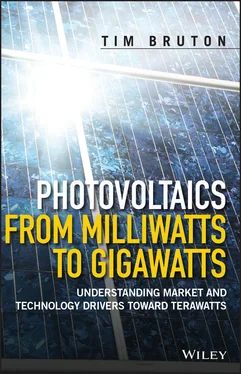1 Cover
2 Title Page Photovoltaics from Milliwatts to Gigawatts Understanding Market and Technology Drivers toward Terawatts Tim Bruton TMB Consulting Woking, UK
3 Copyright Page
4 Dedication Page
5 Preface
6 1 The Photovoltaics: The Birth of a Technology and Its First Application1.1 Introduction 1.2 Sunlight and Electricity 1.3 Photovoltaics Demonstrates Success 1.4 Gallium Arsenide and III–V Alloys for Space 1.5 Summary References
7 2 The Beginnings of a Terrestrial Photovoltaics Industry2.1 Introduction 2.2 The 1973 Oil Crisis 2.3 The Way Ahead for Terrestrial Photovoltaics Technology 2.4 Rise of the US Photovoltaic Manufacturing Industry 2.5 Developments in Europe 2.6 The Transition in Cell Technology from Space to Terrestrial Applications 2.7 Alternatives to Silicon for Solar Cells 2.8 Summary References
8 3 The Early Photovoltaic Global Market and Manufacturers3.1 Introduction 3.2 Off‐Grid Professional Market 3.3 Off‐Grid Domestic Market 3.3.2 Water Pumping 3.4 Summary References
9 4 Silicon Technology Development to 20104.1 Introduction 4.2 Technologies Supplying the Global Market 4.3 Advantages of Silicon as a Solar Cell Material 4.4 Silicon Solar Cell Design Features 4.5 Silicon Solar Cell Manufacturing from 1980 to 1990 4.6 Solar Cell Development to 2000 4.7 Module Technology 4.8 Summary References
10 5 Evolution of Photovoltaic Systems5.1 Introduction 5.2 The Off‐Grid Market 5.3 The Decentralised Grid‐Connected Market 5.4 Utility‐Scale Grid‐Connected Photovoltaic Systems 5.5 Novel Applications 5.6 Summary References
11 6 History of Incentives for Photovoltaics6.1 The Chicken and Egg Problem 6.2 Capital Subsidies on System Purchase 6.3 Feed‐in‐Tariffs 6.4 Power Purchase Agreements and Other Incentives for Large‐Scale Systems 6.5 Summary References
12 7 Difficulties of Alternative Technologies to Silicon7.1 Introduction 7.2 Sheet Silicon Processes 7.3 Thin‐Film Solar Cell Technologies 7.4 Concentrator Technologies 7.5 Summary References
13 8 Current Status of Crystalline Silicon Manufacturing and Future Trends8.1 Introduction 8.2 Approaches to High‐Efficiency Silicon Solar Cells on p Type Silicon Wafers 8.3 Solar Cells with n Type Silicon 8.4 The Future of Photovoltaic Technology: Toward Terrawatts 8.5 Silicon Module Reliability 8.6 Summary References
14 9 Lessons Learnt9.1 Introduction 9.2 Role of Governments 9.3 Role of the Research Community 9.4 Role of the Manufacturing Industry in Europe and the United States 9.5 Role of China as a Photovoltaics Manufacturing Base 9.6 Potential for Continued Market Growth 9.7 Future Technology Development 9.8 Final Analysis References
15 Index
16 End User License Agreement
1 Chapter 2 Table 2.1 Roadmap for the achievement of low‐cost solar systems [9] Table 2.2 Development of the FPSA block tests [11] Table 2.3 Module procurement and structures in the FPSA block tests [12]Table 2.4 Solar cell parameters for a screen‐printed silver front contact and...
2 Chapter 3Table 3.1 Impact of the installation of 1.5 million solar lights in AfricaTable 3.2 World market by sector in the mid‐1980s
3 Chapter 4Table 4.1 Improved process sequence, co‐firing Al BSF and SiNx fire‐through
4 Chapter 5Table 5.1 Annual installations and cumulative installed capacity by country i...Table 5.2 Electricity generation costs for photovoltaics and other technologi...
5 Chapter 6Table 6.1 Global growth in incentives for renewable energy [19]Table 6.2 Most competitive tenders for the supply of photovoltaic electricity...
6 Chapter 8Table 8.1 Main causes of loss in silicon solar cellsTable 8.2 Most efficient solar modules (60‐cell) in 2020, by manufacturer and...
7 Chapter 9Table 9.1 Ranking of the world’s largest photovoltaics manufacturers for 2008...
1 Chapter 1 Figure 1.1 Evolution of electricity‐generating technologies to 2050 Figure 1.2 Charles Fritts’ first photovoltaic array, produced in New York Ci... Figure 1.3 Ohl’s patented solar cell structure [20] Figure 1.4 Schematic of the first successful silicon solar cell Figure 1.5 (A) Normalised spectral response of a p on n silicon solar cell. ... Figure 1.6 Vanguard TV‐3 satellite on display at the Smithsonian Air and Spa... Figure 1.7 Decrease in short‐circuit current of n on p and p on n silicon so... Figure 1.8 Schematic of the Telstar silicon solar cell [46] Figure 1.9 Current–voltage curve for a Telstar cell at 28 °C at 100 mW/cm 2[4... Figure 1.10 Evolution of recorded mono‐ and multicrystalline silicon solar c... Figure 1.11 Textured (100) monocrystalline silicon wafer. Figure 1.12 Bandgap and lattice constant for the important III–V alloys [62]... Figure 1.13 Structure of a 25.7% GaAs solar cell under the AM1.5 Global spec... Figure 1.14 (a) Structure of a tandem cell, showing the tunnel junction.... Figure 1.15 Structure of a very high‐efficiency triple‐junction tandem III–V... Figure 1.16 Assembly of solar arrays for use in space
2 Chapter 2 Figure 2.1 Crude oil prices in $/barrel from 1946 to 2016. Figure 2.2 Import and export of crude oil in the United States from 1920 Figure 2.3 US federal investments in energy R&D 1961–2008 Figure 2.4 Schematic manufacturing process for silicon photovoltaic modules... Figure 2.5 Module lifetime over the duration of the FPSA programme [10] Figure 2.6 Solarex’s ‘solar breeder factory’, Frederick, MD Figure 2.7 Pellworm Island 200 kWp‐array European demonstration project
3 Chapter 3Figure 3.1 Photovoltaic panels on an oil production platformFigure 3.2 Ogami Island lighthouse, Nagasaki, 1966.Figure 3.3 Hybrid photovoltaic–diesel microwave repeater station in Papua Ne...Figure 3.4 Typical photovoltaic‐powered ICCP system in the Libyan Oil Field....Figure 3.5 Photovoltaic‐powered parking meterFigure 3.6 Photovoltaic‐powered vehicle speed measurementFigure 3.7 UK roadside emergency telephoneFigure 3.8 Solar‐powered street light on a building siteFigure 3.9 Two‐axis tracked mirror‐enhanced solar revivers at the Carrisa Pl...Figure 3.10 First European central grid‐connected photovoltaic power plant (...Figure 3.11 Lighting in Africa: (a) photovoltaic‐powered;(b) candleFigure 3.12 Photovoltaic‐powered pump supplying water for crop irrigation in...Figure 3.13 Typical solar‐powered products from the early 1980s.
4 Chapter 4Figure 4.1 Global photovoltaics market by technology, 1980–2017Figure 4.2 Schematic of a p/n junction solar cell, showing the flow of photo...Figure 4.3 Essential features of a simple silicon solar cellFigure 4.4 Dark (upper) and light (lower) current/voltage characteristics of...Figure 4.5 Typical solar cell from 1990Figure 4.6 Schematic layout of a Siemens reactor used in the production of s...Figure 4.7 Wacker Silso casting furnaceFigure 4.8 Cross‐section of part of a Wacker Silso ingotFigure 4.9 Cross‐section of a directionally solidified multicrystalline sili...Figure 4.10 Minority carrier lifetime and solar cell efficiency as a functio...Figure 4.11 First HCT wire sawFigure 4.12 Conceptual image of a silicon car being cut by multiple wires...Figure 4.13 Schematic inline remote‐plasma PECVD system for silicon nitride ...Figure 4.14 LBIC scan of a 1980s‐type 100 mm round monocrystalline cellFigure 4.15 Rear silver grid pattern on a pseudo square CZ waferFigure 4.16 Textured surface of an acid‐etched multicrystalline wafer [82]...Figure 4.17 Typical module construction
5 Chapter 5Figure 5.1 Schematic evolution of the photovoltaics market as price fellFigure 5.2 Evolution of the world photovoltaics market by sectorFigure 5.3 Levelised cost of electricity in different off‐grid locations ver...Figure 5.4 Solar lighting in a Zambian homeFigure 5.5 Annual photovoltaic capacity additions for off‐grid nonresidentia...Figure 5.6 Eco House OxfordFigure 5.7 Block diagram of a typical 1000 Roof Programme domestic system [1...Figure 5.8 Cumulative installations in the German market from 1990 to 2002, ...Figure 5.9 Growth of the Japanese distributed grid‐connected market from 199...Figure 5.10 Large domestic grid‐connected system in GermanyFigure 5.11 Large solar system integrated into the facade of Stadtwerke, ULM...Figure 5.12 Flow of modules into main global marketsFigure 5.13 Evolution of cumulative installed photovoltaic capacity by regio...Figure 5.14 Large‐scale solar system on a supermarket with high self‐consump...Figure 5.15 Photovoltaics LCOE and value of electricity for a residential 5 ...Figure 5.16 Price of polysilicon to the photovoltaics industry, 1995 to 2012...Figure 5.17 550 MWp Topaz Solar Farm, United StatesFigure 5.18 Unmanned ground surveillance drone capable of 90 days’ continuou...
Читать дальше












